 Regular readers of this blog or those that follow the goings-on at the Spaceward site know that TRUMPF decided to help out, big-time, in the upcoming Space Elevator Games. This is well-summarized on the Spaceward web site:
Regular readers of this blog or those that follow the goings-on at the Spaceward site know that TRUMPF decided to help out, big-time, in the upcoming Space Elevator Games. This is well-summarized on the Spaceward web site:
“We’re thrilled to announce that Laser tool manufacturer TRUMPF has stepped forward with a lucrative offer to support teams with its state-of-the-art laser equipment.
Being the world leader in laser technology, TRUMPF took a natural interest in the power beaming games, and is providing both hardware and expertise to enable the 1-km climb.”
I have posed several questions to TRUMPFlger Schlueter about the technology, the upcoming games and TRUMPF’s goals. He (and Dave Marcotte, also of TRUMPF) have kindly answered. Note that if you are unable to read all of the slides or the table, you can click on them for a larger version.
Space Elevator Blog [SEB] – I noticed that in the current issue of “Laser Community” (http://www.trumpf-laser.com/208.img-cust/Laser_Community_03-2007_en.pdf), a TRUMPF publication, the last page states the following: “100,000 Kilometers: Across this distance, laser beams may one day power the motors of the so-called Space Elevator…” Before last year’s Space Elevator Games, were you aware of the concept of the Space Elevator? If so, how did you learn about it?
Holger Schlueter [HS]– Hello Ted ! TRUMPF is a big, multinational company – I actually saw the laser community magazine for the first time yesterday. I was as surprised as you. TRUMPF in Germany was obviously as intrigued by the space elevator concept as we were here in the United States. Maybe they had read the same Spiegel Online article that I had read. Well, anyways, end of October I sent Ben a message with a terribly faulty calculation claiming the space elevator would never work because of the beam divergence. Ben, being the nice and courteous person he is, wrote back friendly and humbly pointed out the embarrasing mistake I had made. So I did the calculation again and realized you actually can transmit a multi-kW laser beam several hundred thousand km into space with manageable divergence. So I repented 😉 and a very good relationship with Ben began.
Did I know about the space elevator before? Faintly in the back of my head I recollect something about the Space Elevator, but I always put it into the realm of impossible science fiction because it seemed so infeasible to me.
[SEB]– What do you think of the idea of a Space Elevator and do you think that TRUMPF equipment can play a key part in its construction?
[HS] – Well, the two big obstacles are:
- Beam divergence and control of multi-kW beams – after correcting the calculation it seems very feasible to me that lasers can provide the necessary 1000 kW class beam with the necessary beam quality.
- Tether strength – I don’t understand much about it – but it seems the teams around the world are making great progress.
As a laser source you have several different options:
- Diode lasers
- CO2 lasers
- Diode pumped solid state lasers – here you have basically another three options – see slide:
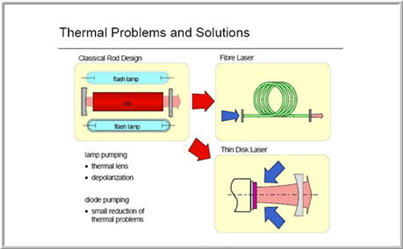 .
.
In evaluating the beam sources there are many aspects to consider, for instance: Power, Scalability, Beam divergence, Efficiency, Wavelength, Receiver efficiency.
Here is a compilation of currently relevant laser technologies:
 .
.
Beam quality and Brightness: Power scalability itself is not the important aspect – it is important to be able to increase the power without changing the beam quality of the beam (for TRUE power scalability see: http://arxiv.org/abs/0711.3987v1). Beam quality is measured as half the beam divergence times the beam radius (units: mm mrad) and tells you for a given beam diameter the divergence of the beam. Beam quality cannot be improved using passive optical elements without reducing the power of the beam. In other words: The brightness (Power per steradian) of a beam source cannot be increased using passive optical elements. This is VERY important for the space elevator, since we want to shoot the beam at a receiver that can be up to 100,000 km away. Ben tells me, one needs full power on the elevator up to a distance of 6,000km then a portion of the beam is good enough. I have to believe him there. So, taking these numbers you have for instance for the available Disk laser: 10 kW with 8 mm mrad beam divergence with a (hypothetical) laser aperture of 10 m diameter sending the beam space ward (I chose 10m as it represents todays largest optical telescope apertures, for instance Keck Observatory in Hawaii – you need diffraction limited optical performance on the sending end – therefore this seems a good comparison to me). In this case the beam grows with a divergence of 1.6e-3 mrad (8 mm mrad / 5000 mm) – the radius therefore grows by 1.6mm for every km – 9600 mm in 6,000km distance. The entire beam therefore has a diameter of 30 m (2 x 9.6m+10m) in 6,000 km distance. That seems quite feasible to me for a space craft as the receiver does not have to be diffraction limited, it only requires the size.
By building more advanced resonators we can filter higher order modes in the disk laser and achieve 12 kW with 1 mm mrad (This is a hero results that was actually achieved in government lab). That already gives us a beam size of 12,4m instead of 30m!
In order to now scale this power to 100 or even 1000kW the thin disk laser gives us several options (from now on I only talk hypothetically and about hero results):
- We can currently extract 7 kW per disk and can put 4 disks optically in series – that should allow us eventually to achieve 28 kW at 1 mm mrad – putting disk in one resonator in series does not decrease the beam quality.
- We can wavelength combine at least 4 different wavelength into a 28 kW x 4 = 112 kW of the same beam quality (since you can superimpose beams of different wavelength without deteriorating the beam quality – called wavelength multiplexing).
This gives us – quite feasible in the next 5 years – 112 kW at 1 mm mrad.
If we would now install 10 separate beam stations that would track the space elevator with a gimble system we can achieve 1000 kW beam with TODAYS’ technology!
BUT NOW TO ANSWER YOUR QUESTION:
The most important property of the Thin Disk Laser is its ability to be scaled into the 100 kW regime without sacrificing beam quality. This is the major advantage the Thin Disk Geometry has over the fiber geometry for the space elevator project. For an exact definition of power scalability see the following article: http://arxiv.org/abs/0711.3987v1. In this slide you can see that limitations on the scalability of the disk concept to power becomes relevant only at 100 kW per disk or more.
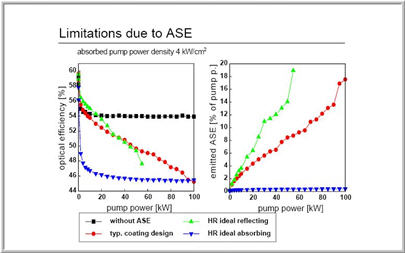 .
.
Another big obstacle will be the receiver efficiency at the different wavelengths.
- Diodes have an advantage since their emission wavelength can be tailored to match maximum quantum efficiency of the receiver material and they are they might even allow the usage of Si as the receiver material. TRUMPF has a diode laser factory near Princeton, New Jersey – I was their GM for three years – and I can see possible advances with super high brightness diodes and dense wavelength multiplexing that might make this another good contender for the beam source of a real elevator.
- CO2 lasers emit at 10.6 um – there is no direct conversion using the photoelectric effect feasible – therefore you would need a thermoelectric conversion process, for instance a sterling engine could be used.
- The diode pumped solid state lasers (Disk, Fiber, Rod) emit beyond the fundamental absorption line of Si and therefore need Ge receivers or even ATJ (advanced triple junction – three different receiver types on top of each other) (see the graph below and the white paper link below):
 .
.
Excerpt from http://www.emcore.com/assets/photovoltaics/Emcore_Manuscript_Fatemi_3P-B5-03_WCPEC-3.pdf.
Ben should tell you some more about the finite efficiency of all receivers, as this will provide maybe the THIRD large challenge for the space elevator project – how do you actually remove the excess heat in space that stems from the limited efficiency of any such receiver. And the heat generated may be substantial: Imagine a 1000 kW beam converted with 80% efficiency – you still have to cool 200 kW – how do you do that in vacuum?
[SEB] – What are you offering this year to teams who want to use your equipment?
[HS]– We have promised to offer at least a 8 kW TruDisk laser with 8 mm mrad. This laser is fiber delivered and the teams would have to interface into our safety system and our fiber delivery receptacle. We can provide all the necessary documentation and components for the teams. They will also get enough test time at our or our partners labs. The project leader for the actual interaction with the teams is Dave Marcotte, our national head of the service and training organization – he is a space enthusiast himself I would like you to ask him directly about the exact deliverables of TRUMPF.
Dave Marcotte [DM]– We look forward to assisting the groups as they progress. We are estimating the need for 4 “hot laser” testing opportunities for each team at intermediate points in the development process. We also plan to have a “dress rehersal” before the big competition. TRUMPF and the teams will need to work together on the “design of test” for each phase. We have highly knowledgeable people in our Service Group, Product Management and R&D who can be referenced for insight on laser technology, optics, interfacing, safety and integrated systems.
[SEB]– I understand that TRUMPF will be interviewing contestants in this year’s Space Elevator Games at the upcoming Photonics West Trade Show. What are you going to be looking for?
[DM]– Difficult question. Basically, I feel key elements of a successful development project are knowledge, organization, attitude and resources. We will consider the skill set of the group and how the players are presented as a knowledge base. We will consider the proposed approach to solving the problem, more than the hypothetical solution. An organized project plan with a best guess on which skills will be utilized is important to pulling the various technologies together into an integrated solution. Frequently I have seen attitude as a defining difference when presented with development frustrations and failures encountered by individual members and the team. There is a saying… something like…. “Inspiration vs Perspiration”. Available resources are unfortunately not connected to knowledge, organization and attitude. I have seen great guys, who work together seamlessly, but without resources (hardware, software, time, space…) they are starved and unable to demonstrate success. The resources the group brings to the table will complete TRUMPF’s contribution.
[SEB] – Are you planning on attending the Space Elevator Games this year?
[HS] – Absolutely & I hope to ride the first elevator in 2025.
[DM]– As project manager I plan to be at the games to make sure the laser is transported, installed and operating, with all teams supported. As for the first elevator ride… I will keep the load balanced, riding with Holger. 🙂
Thank you very much gentlemen for your time. I look forward to meeting you at the upcoming Games.
 In a recent episode of The Space Show, the show’s host, Dr. David Livingston, interviewed Bruce Pittman. The topic of the show was Fusion Power – what is the status, when might it be available, problems in creating it, etc. Now frankly, I know very little about the ins and outs of fusion power, how feasible it is, etc., so I’m in no position to judge Mr. Pittman’s veracity or expertise on this subject. What did interest me, however (and why I’m mentioning this interview on the Space Elevator Blog), was when a listener asked Mr. Pittman about what he thought what was “more realistic”; fusion power for rocket propulsion or a Space Elevator. Not surprisingly, Mr. Pittman said “fusion power”. He freely admits he doesn’t know much about the Space Elevator, but says that, based on his trips to the last “two X-Prize Cups” to watch the Space Elevator Games (?!), there seems to be some “real challenges” to building a Space Elevator, specifically wind issues (and tether strength) and the problem with space debris.
In a recent episode of The Space Show, the show’s host, Dr. David Livingston, interviewed Bruce Pittman. The topic of the show was Fusion Power – what is the status, when might it be available, problems in creating it, etc. Now frankly, I know very little about the ins and outs of fusion power, how feasible it is, etc., so I’m in no position to judge Mr. Pittman’s veracity or expertise on this subject. What did interest me, however (and why I’m mentioning this interview on the Space Elevator Blog), was when a listener asked Mr. Pittman about what he thought what was “more realistic”; fusion power for rocket propulsion or a Space Elevator. Not surprisingly, Mr. Pittman said “fusion power”. He freely admits he doesn’t know much about the Space Elevator, but says that, based on his trips to the last “two X-Prize Cups” to watch the Space Elevator Games (?!), there seems to be some “real challenges” to building a Space Elevator, specifically wind issues (and tether strength) and the problem with space debris.

 While perusing the current list of team’s entered into this year’s Climber/Power-Beaming competition, I noticed that the
While perusing the current list of team’s entered into this year’s Climber/Power-Beaming competition, I noticed that the  Back in January of 2007, the Discovery Channel Series 2057 aired an episode which used a Space Elevator as a backdrop. I wrote about it
Back in January of 2007, the Discovery Channel Series 2057 aired an episode which used a Space Elevator as a backdrop. I wrote about it  Regular readers of this blog or those that follow the goings-on at the Spaceward site know that TRUMPF decided to help out, big-time, in the upcoming Space Elevator Games. This is well-summarized on the
Regular readers of this blog or those that follow the goings-on at the Spaceward site know that TRUMPF decided to help out, big-time, in the upcoming Space Elevator Games. This is well-summarized on the 


 .
. The University of Michigan’s
The University of Michigan’s  Teams competing in this year’s Space Elevator Games are sure to beat a path to the DILAS booth at the Photonics West Exhibition. Both USST and Lasermotive, the two laser-powered teams in the 2007 Space Elevator Games, used Laser Diode products from DILAS to power their climber and many more are certainly considering using them this year.
Teams competing in this year’s Space Elevator Games are sure to beat a path to the DILAS booth at the Photonics West Exhibition. Both USST and Lasermotive, the two laser-powered teams in the 2007 Space Elevator Games, used Laser Diode products from DILAS to power their climber and many more are certainly considering using them this year. As I
As I 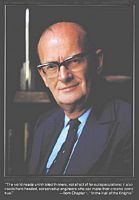 It is no mystery why this blog has had several references / postings to Arthur C. Clarke. In addition to being an outstanding sci-fi writer and futurist, he is also the guy who, more than anyone else, has popularized the concept of a Space Elevator.
It is no mystery why this blog has had several references / postings to Arthur C. Clarke. In addition to being an outstanding sci-fi writer and futurist, he is also the guy who, more than anyone else, has popularized the concept of a Space Elevator.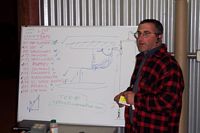
 It’s amazing – I was on vacation for about a week and got just SO far behind.
It’s amazing – I was on vacation for about a week and got just SO far behind. The first half of this 25 minute long YouTube video (originally from
The first half of this 25 minute long YouTube video (originally from  On June 11th,
On June 11th,  This quote is taken from Dr. Brad Edward’s PowerPoint presentation posted on the
This quote is taken from Dr. Brad Edward’s PowerPoint presentation posted on the  On
On  As those of you who got up early to try and watch the CBS Sunday Morning Space Elevator segment I
As those of you who got up early to try and watch the CBS Sunday Morning Space Elevator segment I  The LiftPort Blog
The LiftPort Blog 
 NPR interviews Robert Hoyt, of Tether’s Unlimited
NPR interviews Robert Hoyt, of Tether’s Unlimited  Search engines are weird sometimes; yesterday they found this Howard Lovy June 27, 2004
Search engines are weird sometimes; yesterday they found this Howard Lovy June 27, 2004  But the real prize in this blog entry was its mention of a Dave Barry column on the Space Elevator. The link to the column doesn’t work anymore, but I hunted around and found an archived copy of it – you can view it
But the real prize in this blog entry was its mention of a Dave Barry column on the Space Elevator. The link to the column doesn’t work anymore, but I hunted around and found an archived copy of it – you can view it  The final, detailed, program for the upcoming
The final, detailed, program for the upcoming  Over on this Blog’s sidebar, in the Images & Animation section, I’ve posted a video summary of the 2006 Space Elevator Games. It’s the best one I’ve found and I’ve had hopes that it’s producers would put it up on their website, in archives or something. Alas, it has not happened and they have refused to respond to repeated emails on my part.
Over on this Blog’s sidebar, in the Images & Animation section, I’ve posted a video summary of the 2006 Space Elevator Games. It’s the best one I’ve found and I’ve had hopes that it’s producers would put it up on their website, in archives or something. Alas, it has not happened and they have refused to respond to repeated emails on my part.
 One of the organizations I belong to is
One of the organizations I belong to is 
 When the Nova Science Now
When the Nova Science Now  I was surprised to learn that NASA is NOT interested in the Beam Power Competition to power a Space Elevator, nor are they interested in the Tether competition to build a Space Elevator. Ken put it quite bluntly: “NASA’s not interested in Space Elevators…”, at least not as far as the Centennial Challenges are concerned. NASA is looking at the results / winners / new technologies developed out of the Beam Power competition for Lunar exploration purposes and they are looking at the Tether competition for fundamental materials research. However, by partnering with the Spaceward Foundation for these two challenges, NASA is getting what it wants while helping us Space Elevator believers further our goal.
I was surprised to learn that NASA is NOT interested in the Beam Power Competition to power a Space Elevator, nor are they interested in the Tether competition to build a Space Elevator. Ken put it quite bluntly: “NASA’s not interested in Space Elevators…”, at least not as far as the Centennial Challenges are concerned. NASA is looking at the results / winners / new technologies developed out of the Beam Power competition for Lunar exploration purposes and they are looking at the Tether competition for fundamental materials research. However, by partnering with the Spaceward Foundation for these two challenges, NASA is getting what it wants while helping us Space Elevator believers further our goal.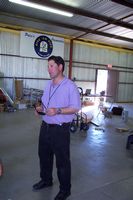
 Well, I wasn’t quite sure what to expect with this show, but I thought it would be something along the lines of the Science Channel show – a “Space Elevator primer” as it were.
Well, I wasn’t quite sure what to expect with this show, but I thought it would be something along the lines of the Science Channel show – a “Space Elevator primer” as it were.